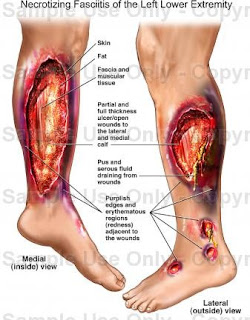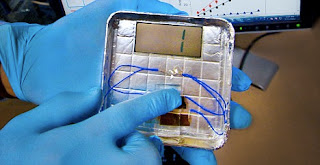'This is a nose we’re growing for a patient next month,’ Professor Alexander Seifalian says matter-of-factly, plucking a Petri dish from the bench beside him.
Inside is an utterly lifelike appendage, swimming in red goo. Alongside it is another dish containing an ear. ‘It’s a world first,’ he says smiling.
‘Nobody has ever grown a nose before.’
His lab is little more than a series of worn wooden desktops strewn with beakers, solutions, taps, medical jars, tubing and paperwork, and looks like a school chemistry lab.
But it’s from here that Seifalian leads University College London’s (UCL) Department of Nanotechnology and Regenerative Medicine, which he jokingly calls the ‘human body parts store’.
 |
| Seifalian showing Nose made from nanomolecules |
As he takes me on a tour of his lab I’m bombarded with one medical breakthrough after another. Daily Mail Reporter Said
At one desk he picks up a glass mould that shaped the trachea – windpipe – used in the world’s first synthetic organ transplant.
At another are the ingredients for the revolutionary nanomaterial at the heart of his creations, and just beyond that is a large machine with a pale, gossamer-thin cable inside that’s pulsing with what looks like a heartbeat. It’s an artery.
‘We are the first in the world working on this,’ Seifalian says casually to daily mail reporter. ‘We can make a metre every 20 seconds if we need to.’
‘Other groups have tried to tackle nose replacement with implants but we’ve found they don’t last,’ says Adelola Oseni, one of Seifalian’s team.
‘They migrate, the shape of the nose changes. But our one will hold itself completely, as it’s an entire nose shape made out of polymer.’
Looking like very thin Latex rubber, the polymer is made up of billions of molecules, each measuring just over one nanometre (a billionth of a metre), or 40,000 times smaller than the width of a human hair. Working at molecular level allows the material itself to be intricately detailed.
 |
| Ear made in lab |
‘Inside this nanomaterial are thousands of small holes,’ says Seifalian.
‘Tissue grows into these and becomes part of it. It becomes the same as a nose and will even feel like one.’
When the nose is transferred to the patient, it doesn’t go directly onto the face but will be placed inside a balloon inserted beneath the skin on their arm.
After four weeks, during which time skin and blood vessels can grow, the nose can be monitored, then it can be transplanted to the face.
At the cutting edge of modern medicine, Seifalian and his team are focusing on growing replacement organs and body parts to order using a patient’s own cells. There would be no more waiting for donors or complex reconstruction – just a quick swap.
And because the organ is made from the patient’s own cells, the risk of rejection should, in theory, be eliminated.
Unsurprisingly, the recipe for the breakthrough biocompatible material used is a closely guarded secret.
From those who have lost noses to cancer to others mutilated by injury, it’s hoped this revolutionary process could transform thousands of lives.
‘We seed the patient’s own cells on to the polymer inside a bioreactor,’ says Oseni.
This is a sterile environment mirroring the human body’s temperature, blood and oxygen supply.
‘As the cells take hold and multiply, so the polymer becomes coated. The same methods could be applied to all parts of the face to reconstruct those of people who have had severe facial traumas.’
‘The full success of these implants needs to be tested with a larger number of patients in clinical trials,’ says Seifalian.
Such is the speed of progress that regenerative medicine is now moving on from replacing heart valves and rebuilding faces to potentially curing blindness and accelerating the study of some of the most debilitating diseases.
The UK is at the forefront of this research, with work on a £54 million MRC Centre for Regenerative Medicine in Edinburgh completed earlier this year.
Until recently, regenerative medicine focused mostly on embryonic stem cells as these were the most versatile. They are called pluripotent, meaning they have the ability to become any cell type – blood, muscle, etc.
By contrast, adult stem cells can replicate themselves endlessly, but only as the cell they began life as – skin cells replicate as skin cells, muscle cells as muscle cells.
But the moral debate surrounding embryonic stem cell research is controversial.
Stem cells are taken from human embryos, which are destroyed in the process.
In 2007, Professor Shinya Yamanaka of Kyoto University managed to create pluripotent cells from adult stem cells, potentially removing the need for embryonic stem cells completely.
These are known as induced pluripotent stem cells, or iPSCs. He was in part inspired by Professor Ian Wilmut, who was knighted for his role in the creation of Dolly the cloned sheep.
‘In the same way Dolly made us think maybe we could change cells, Yamanaka proved it could be done,’ says Wilmut.
‘This makes you think you can produce any cell type, producing nerves or muscle from skin cells, for example.’
This has been proved recently with the news that scientists at Cambridge Universityhave created brain cells from skin cells which could help with the search for new treatments for Alzheimer’s, stroke and epilepsy.
Sitting on a desk inside Seifalian’s laboratory is the mould for the trachea which he and his team created. It was recently implanted into a patient making it the world’s first ever synthetic organ transplant.
The patient in question, a 36-year-old Eritrean man, had a large cancerous tumour in his throat that was rapidly spreading towards his lungs. The transplant was successful, and the patient is now out of hospital and recovering well.
On another bench in the lab lies an ear ready for seeding, while next door the team is working on heart valves that won’t even need seeding before implantation, having been developed instead to attract the cells they need once implanted.
This will allow them to grow in the body instead of bioreactors and, along with an insertion method that removes the need to open the chest, could revolutionise heart bypass surgery.
‘Normally for heart bypass you take a section of vein from the patient’s leg or arm. But 30 per cent of patients don’t have suitable veins so can’t have the operation. No alternative currently exists for them,’ says Seifalian.
‘We are the first in the world with this. Nobody else is even close. It has been successful in animal trials; this year it will be going for patient trials’.
While Seifalian and his team keep developing potential implants, on the other side of Londonanother team led by Professor Pete Coffey, the London Project to Cure Blindness, is using stem cells to tackle age-related macular degeneration, the most common form of age-related sight loss, which affects 513,000 people in the UKalone.
‘There’s nothing that can be done for those with the disease,’ says Coffey. ‘There’s a real unmet need here.’
The aim is to replace the diseased cells with healthy new ones, restoring vision.
Unlike Seifalian’s team, Coffey’s is using embryonic stem cells because in every experiment to date they are the only ones that work.
On the issue of working with embryonic stem cells Coffey is clear.
‘One thing I always face is that the term embryo has a different meaning for different people.
'The embryo in this case is five days old, and I know under various religious definitions that’s life, but I see this as similar to organ donation. That embryo cannot survive on its own.’
Most embryonic cells used in research, including Coffey’s, are from IVF treatment where a large surplus of embryos is part of the process. Unwanted embryos can be donated to research, otherwise, as Coffey says, ‘they’re disposed of.’
‘A human embryonic cell keeps reproducing itself naturally, so one cell generates everything we need – we’ve banked the duplicates in nitrogen chambers in three different countries – which means this cell could service a clinical population of 28 million. Isn’t that worth it?’
Coffey’s project is perhaps the most advanced major regenerative medicine project in the world today, scheduled for clinical trials with patients later this year. But even success in a patient trial is no guarantee a treatment will ever reach the mass market.
‘The sad thing is the time frame here,’ says Paul Whiting, executive director of Pfizer’s regenerative medicine arm, who is working closely with Coffey’s project.
‘Even things that seem close are probably ten years away, while many are 20 to 50 years away. We need to know if these things will do long-term harm before they can reach patients, so it will be a gradual progression over at least 50 years.’
And a recent study illustrates just how far the divide between laboratory success and clinical reality could be: researchers at California University have found that mice treated with iPSCs made from their own skin cells ultimately reject the transplants.
When asked about this, Wilmut agrees it was valid but also says it was ‘a very preliminary observation’, another piece of the puzzle leading toward full understanding of the subject. There are also concerns that the reprogramming process used to create iPSCs might cause cancer in those same cells.
But back in Seifalian’s labs, the raw energy remains.
‘Before, the idea was you rob Peter to pay Paul, taking one bit of the body to reconstruct another, but now the idea of being able to grow tissues in a lab and to reconstruct the body is huge,’ says Adelola Oseni.
‘If we can grow a heart, a lung or a trachea in a lab, we don’t need to wait for donors.
'This work has massive implications for the way we function as clinicians and the way medicine is practised.’
Source : Daily Mail


































+users+with+similar+interests+to+be+your+'friends',+located+via+their+phones.jpg)











